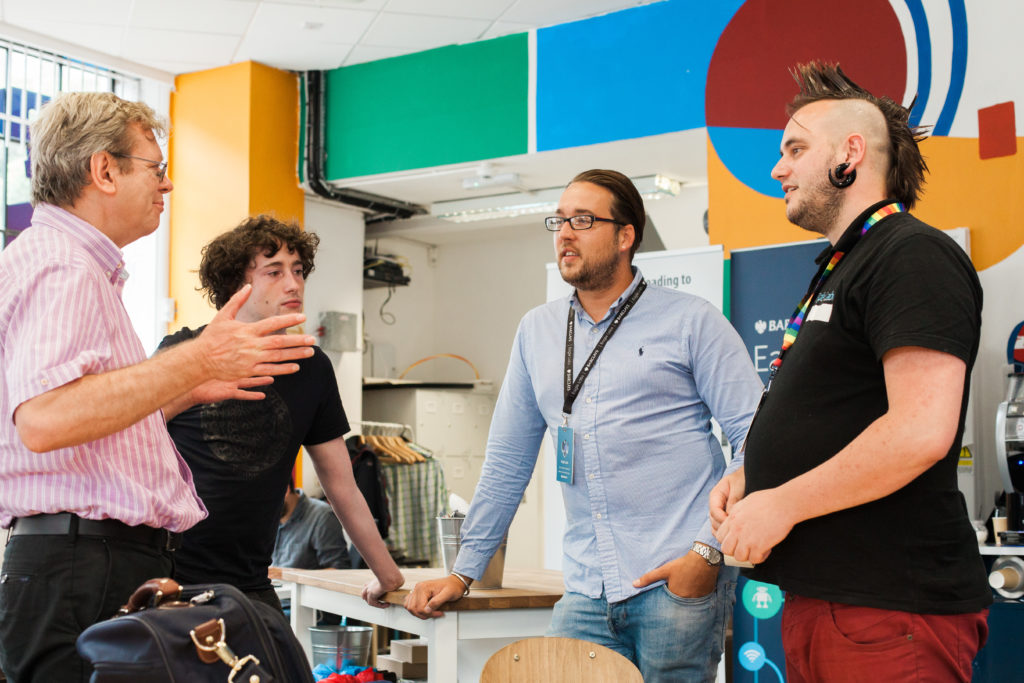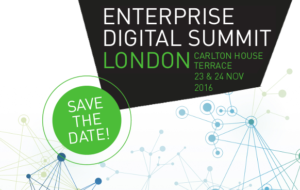Back at our first, November 2014 version of the Enterprise Digital Summit London, Dave Shepherd, Director of Eagle Labs & Digital Eagles for Barclays Bank, came to speak about their Digital Eagles programme. Barclays decided to create a team of front line staff who are on hand in branches across the UK, actively encouraging and educating customers and non-customers to acquire digital skills, so they feel confident to explore technology – a team of over 12,000 has been created so far. Dave invited me down to Brighton to visit their latest initiative – a network of business incubators and fully equipped maker spaces called Eagle Labs. Barclays are an excellent example of a well known, established brand with a long history that is approaching Digital in a new way.
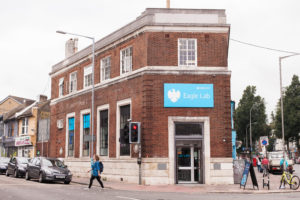 They are re-using under utilised branch offices or other spaces to create this network of Eagle Labs. They piloted the idea in Bournemouth and then Cambridge – Brighton was the third. They’ve got 6 now, Notting Hill in London opens shortly, with Jersey, Norwich, Salford on the cards. Barclays are taking a “fail fast” approach, trying things out in each new Lab, and learning as they go. The initiative itself feels more like a start-up than something run by a big corporate entity, and I’m sure that difference in cultural approach is key to making this a success.
They are re-using under utilised branch offices or other spaces to create this network of Eagle Labs. They piloted the idea in Bournemouth and then Cambridge – Brighton was the third. They’ve got 6 now, Notting Hill in London opens shortly, with Jersey, Norwich, Salford on the cards. Barclays are taking a “fail fast” approach, trying things out in each new Lab, and learning as they go. The initiative itself feels more like a start-up than something run by a big corporate entity, and I’m sure that difference in cultural approach is key to making this a success.
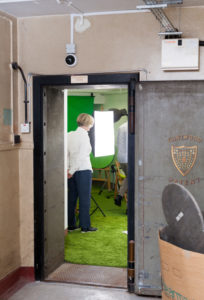 The space I visited is a perfect example of what they are trying to achieve. The building started life as the Brighton Union Bank back in 1870. It had been a Barclays branch for decades, but had closed, laying derelict and empty. The lease runs to 2018. Barclays have smartened up the outside, reclaimed and refurbished the space, finding ways to convert the old branch infrastructure for its new use as cost effectively as possible. The old branch manager’s office has become their maker lab with a laser cutter, 3D printer and all of the tools you would need to build a prototype for your business idea. One of the old bank vaults downstairs, with it’s very impressive steel door has become a photographic studio. Rather than take the corporate approach of laying expensive new flooring and a typical office refit, they’ve sanded down the old parquet flooring, renovated the old doors and are trying to retain as much of the character of the building’s history as they can, much as you would with a house renovation project. The old bank “front of house” has become shared office space for the incubator start-ups and small business. An office upstairs where cheques and local accounts would have been processed has become a presentation and meeting room for hire, with more of the feel of the kind of space you would find at Google, with bean bags and a coffee table made from a big old reel for industrial cable – not what you would expect from one of the oldest retail banks in the country.
The space I visited is a perfect example of what they are trying to achieve. The building started life as the Brighton Union Bank back in 1870. It had been a Barclays branch for decades, but had closed, laying derelict and empty. The lease runs to 2018. Barclays have smartened up the outside, reclaimed and refurbished the space, finding ways to convert the old branch infrastructure for its new use as cost effectively as possible. The old branch manager’s office has become their maker lab with a laser cutter, 3D printer and all of the tools you would need to build a prototype for your business idea. One of the old bank vaults downstairs, with it’s very impressive steel door has become a photographic studio. Rather than take the corporate approach of laying expensive new flooring and a typical office refit, they’ve sanded down the old parquet flooring, renovated the old doors and are trying to retain as much of the character of the building’s history as they can, much as you would with a house renovation project. The old bank “front of house” has become shared office space for the incubator start-ups and small business. An office upstairs where cheques and local accounts would have been processed has become a presentation and meeting room for hire, with more of the feel of the kind of space you would find at Google, with bean bags and a coffee table made from a big old reel for industrial cable – not what you would expect from one of the oldest retail banks in the country.
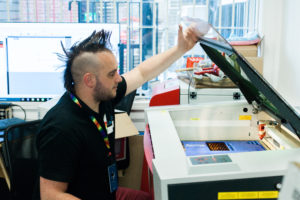 Barclays aren’t taking a traditional venture capital style incubator approach. They don’t take a stake in the businesses, although they do pay rent to the Lab, and of course Barclays would like to bring them on board as business banking customers. However, a key part of what they are trying to do is connect to the local business community and build relationships in the way that a local branch manager would have done in the past, before retail banks started to centralise everything in the quest for cost savings and efficiency. They want to build an ecosystem of coaching, support and partners who work from the Lab to help the members and connect with the local area. While I was there I met two locals who had left corporate jobs to freelance in marketing and training – something that’s happening a lot around the UK. They’d popped in to use the photographic studio for half an hour to take better quality head shots for their LinkedIn profile. I saw the laser cutter demonstrated
Barclays aren’t taking a traditional venture capital style incubator approach. They don’t take a stake in the businesses, although they do pay rent to the Lab, and of course Barclays would like to bring them on board as business banking customers. However, a key part of what they are trying to do is connect to the local business community and build relationships in the way that a local branch manager would have done in the past, before retail banks started to centralise everything in the quest for cost savings and efficiency. They want to build an ecosystem of coaching, support and partners who work from the Lab to help the members and connect with the local area. While I was there I met two locals who had left corporate jobs to freelance in marketing and training – something that’s happening a lot around the UK. They’d popped in to use the photographic studio for half an hour to take better quality head shots for their LinkedIn profile. I saw the laser cutter demonstrated 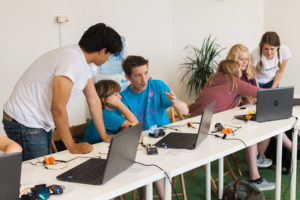 to some people with a product idea. I met Ryk, a user experience expert who runs TeamPro, a great looking start-up that works from the shared office space that provides free websites for sports teams. I heard about open days for local businesses that the Lab runs to show what they do. I saw that they run “Mend it Mondays” – for £5 they have an open session where their on-site technicians will help fix your broken stuff, or use the workshop to build new things.
to some people with a product idea. I met Ryk, a user experience expert who runs TeamPro, a great looking start-up that works from the shared office space that provides free websites for sports teams. I heard about open days for local businesses that the Lab runs to show what they do. I saw that they run “Mend it Mondays” – for £5 they have an open session where their on-site technicians will help fix your broken stuff, or use the workshop to build new things.
I was introduced to Dave’s boss Steven Roberts, Strategic Transformation Director at the Bank. He told me:
“Bankers have traditionally been at the heart of their community, helping people with their finances, and supporting local business. The Eagle Labs initiative aims to strengthen that connection with direct help in new ways of working and emerging technology for start-ups and local businesses. After Digital Eagles it’s the logical, next step for us to be building digital skills in the business community.”
The Brighton Lab provides a home for business advisors, brokers, web site designers, and businesses creating new apps and digital services. It hosts 2 permanent offices with 4 staff in each, has 2 meeting spaces for hire or use by the members, a maker space, and the main area supports 25 co-workers. They’ve linked to the local maker community and provide a hub for emerging technology in the local community. Compared to their peers, Barclays are thinking differently, and doing digital differently.
All photographs by Rhys Terrar
Extras:
30 photographs from our visit to the Brighton Eagle Lab
Steam Co’s video of the Brighton Eagle Lab Launch (with Steven Roberts and Dave Shepherd):
Find out more about this year’s Enterprise Digital Summit London:

